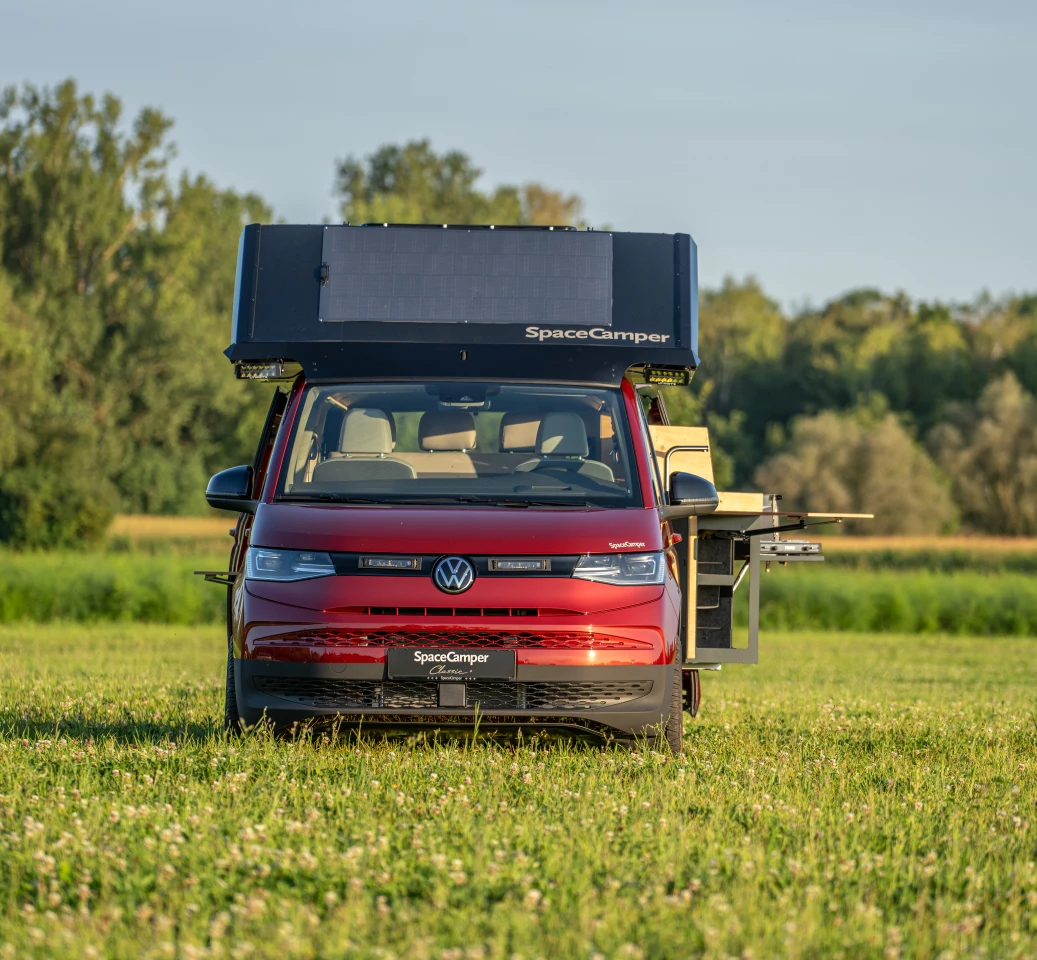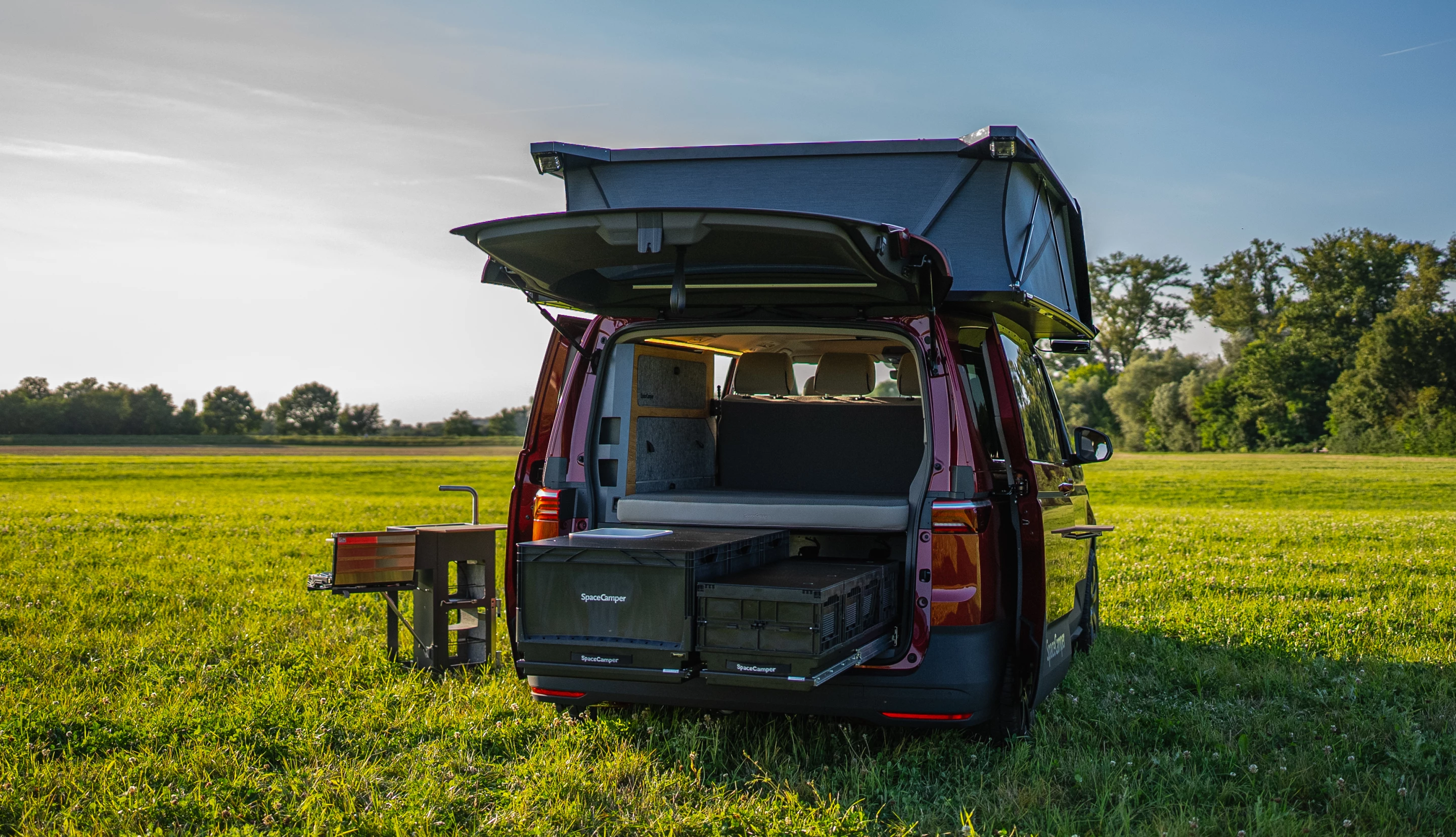Germany's SpaceCamper prides itself on pushing the boundaries of what a camper can be, to the point of building an unexpected amalgamation of tent camper, e-cargo bike and micro-motorhome. So perhaps it's not surprising to see it introduce the wildest pop-up camper van at the 2024 Düsseldorf Caravan Salon. And yet, it still is. SpaceCamper's Volkswagen Multivan pop-up concept is unlike anything we've ever seen, blurring the lines between a rooftop tent, high fixed sleeper roof and standard pop-top.
SpaceCamper uses Volkswagen's new Multivan panoramic glass sunroof option as a jumping off point for its SpaceRoof concept, removing the factory glass to create a pass-through without even having to replace the entire factory roof. It then drops on the oversized SpaceRoof as a new style of pop-top that functions somewhere between a rooftop tent and an RV sleeper roof.
Like a rooftop tent, the ~75-kg (165-lb) SpaceRoof is fully removable, securing to the factory anchor points that Volkswagen uses for its roof rails. It measures wider than the van roof, stretching its way out even with the folded side-view mirrors, in a sort of otherworldly spin on the idea of a "T-top." The extra width not only increases internal space but serves as a set of overhanging eaves that prevent rain from falling inside when the sliding doors are left open to enjoy the sound and cooling of the rain.

Like an integrated pop-up camper van roof, the SpaceRoof concept offers entry directly from inside the van. So if that storm is still raging, you don't have to scurry outdoors and up a ladder.
The SpaceRoof's extra-wide construction may look a little odd from the outside, but it accommodates a 140 x 200-cm (55 x 79-in) transverse bed that remains set up without sacrificing standing room in the van – need to lift a bed up during the day to enjoy standing room. The oversized roof area even has room for a wardrobe that breaks down when it's time to lower the roof.

The fixed high-roof aspect of the SpaceRoof might be its strangest feat. Quite unexpectedly, given its oversized form, the roof is designed to stay open while driving, something that the typical pop-up roof or rooftop tent is definitely not designed to do. Campers can thus use the SpaceRoof as a cargo box, getting luggage out of the main van cabin during the ride. At camp, pop-top setup is already done, freeing travelers to get to work on other parts of making camp or simply leap upstairs to bed.

Keeping the roof up is sure to introduce more drag and result in a fuel economy penalty, but that could be said of a high roof or rooftop tent, too. There's no indication yet of how much that penalty might be, but SpaceCamper does say the roof is designed for speeds up to 120 km/h (75 mph).
After realizing you can drive with it up, you might be wondering if the SpaceRoof even needs to fold back down. It is designed to lower, not only to cut down on drag but also to drop overall vehicle height to 197 cm (78 in), below the ever-important parking garage and ferry threshold of 2 meters (79 in). So SpaceRoof owners can still comfortably drive and park around the city.
We haven't yet seen any photos or video of the SpaceRoof lowered and packed up, but it's still a prototype so might not be working properly yet. It definitely has some rough prototype edges that we're sure will be smoothed out on the way to production.

The SpaceRoof is the optional cherry buyers can plop on top of a Multivan Classic+ package. With Volkswagen's split of the Transporter and Multivan, SpaceRoof has focused on the latter by evolving its long-running Classic package into the Classic+, which it is also offering for the Ford Tourneo Custom.
The Classic+ includes a three-seat rear folding bench/bed with under-seat drawers, swivel front seats, rear cabinetry, and a unique swiveling kitchen. The kitchen can be used inside or swiveled out the sliding driver-side door for outdoor cooking. The fridge box remains inside, either way. The bed is 200 cm (79 in) long with a width that varies between 120 and 136 cm (47 and 54 in) when set up.

The Classic+ also includes a robust power package with 200-Ah lithium battery, 2,000-W inverter and external 230-V shore power hookup. An air heater and interior lighting round out the package. SpaceCamper also offers options including a rear cargo slide designed to fit Euroboxes, a larger rear slide-out fridge, and a rear slide-out kitchen,
As company founder Ben Wawra tells us, the Multivan setup works particularly well for those who seek a simple two-person camper van and everyday MPV but might need to bring others along on camping trips. Grandparents and young couples who plan to have children are good examples of those who could enjoy the Classic+ package for the average trip but then have a dedicated upstairs kids room whenever they need it. And unlike the typical pop-up roof, the SpaceRoof can be a full-time kids space, storing luggage, toys and other belongings on the ride and at camp.

We're not sure we love the SpaceRoof's huge size and strange look, but we certainly like to see someone rethinking a camper component design as standard and ubiquitous as the pop-up roof. SpaceCamper hopes to bring the SpaceRoof to market within a year and is looking to adapt it to other vans beyond the Multivan, including larger full-size models.
So there might just be an even bigger, more awkward pop-top in camping's future.
Prototypes don't tend to come with pricing, and we're waiting to hear back on a quote for a base turnkey Camper+ Multivan. So as not to leave you cold and shut out of the ballpark entirely, though, we checked SpaceCamper's listings for two of the last available T6.1 Classic camper vans, which price in at €90,000 and 100,000 (approx. US$99,775 and 110,875), respectively.
Source: SpaceCamper





















